
In this free flying cross country tips article, Flybubble team pilot Phil Clark shares with you his key learning points from an ambitious planned closed-circuit XC flying task and shows us that, done right, flying teamwork can make freeflight dreamwork.
First Phil sets the scene for context, then he recounts the defining moments of the day and shares his key learning points...
In March 2020 my lofty plans to fly loads and compete in the British Paragliding Open this year took a spectacular nosedive as COVID-19 struck the world stage and the UK went into lockdown. Come mid May the lockdown was eased and fledgling flight plans were soon hatched in a bid to salvage something of the remaining cross country flying season. Since straight-distance flights meant uncertain retrieves and possible hitchhiking with strangers to get back, closed-circuit flights like out-and-returns and triangles--or any kind of polygon you fancied--were in order.
One fine day in May the soaring forecasts were looking good for the most marvellous Malvern Hills. To avoid a wasted trip, causing problems for others or losing flying sites, before making any plans I first double-checked the current situation with the local flying club (in this case the Malvern Hang Gliding Club), the airspace (check current official air charts) and NOTAMs to be sure these were all okay. Having confirmed this, some flying friends and I headed for those there hills, excited!
Kettle Sings twice
So it came to be that a flying task was set from from Kettle Sings launch which consisted of two laps of an already fairly ambitious triangle out over the flats. Something a little like the following... twice!
 The planned flight task, viewed in XC Planner
The planned flight task, viewed in XC PlannerThere's nothing quite like prepping for a 6 hour flight than a 3 hour car drive but in reasonable time Luis, Andy and I were at the car park debating whether it was way too windy to even fly, let alone attempt the task. I was optimistic it would improve. After all, the forecast was for it to be OK from 1pm and good by 2pm, and it was currently barely 11am.
We took a slow wander up the hill. There was some debate about the risk versus reward, site briefings, and much caution for the trees and towns below. Then a few came up by air from the southern end of the ridge and the collective groundsuck spell was broken.
Time to fly!
Luis tends to abide by the mantra of "If it's flyable, why be on the ground?"' so was first off the mark. Andy was hot on his heels at the next lift cycle. For all the breeze it wasn't particularly soarable at launch. I lagged behind, faffing with the task, the turnpoints and my Flymaster LIVE SD vario, cursing the lack of touch-screen that the others with their Oudies, Voliriums and phone solutions had. Faff over, I was off after them too.

Once up in the air I headed straight for the northern end of the 300m ridge, topping up just enough to get to the next section of reliably soarable ridge. We had agreed to try the task regardless of the 25kph base layer winds, it was pretty flat terrain out front so progress might well be slow but we should be able to persevere if we worked together.
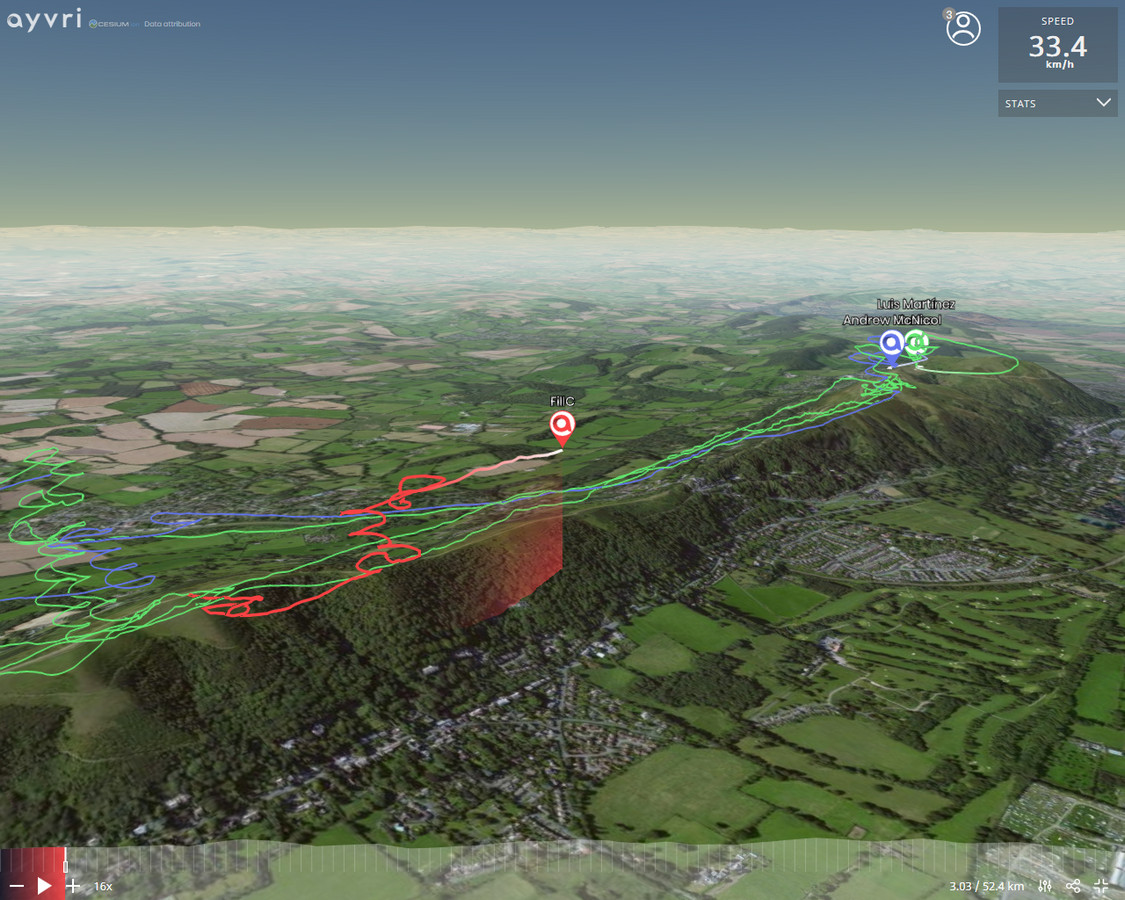 Flight tracklogs viewed on ayvri. Red Phil, blue Andy, green Luis.
Flight tracklogs viewed on ayvri. Red Phil, blue Andy, green Luis.I could see Andy and Luis up ahead, clearly drifting with the climbs but as they pushed back forwards off the ridge once more they hooked a climb and I was able to tag on and catch up.
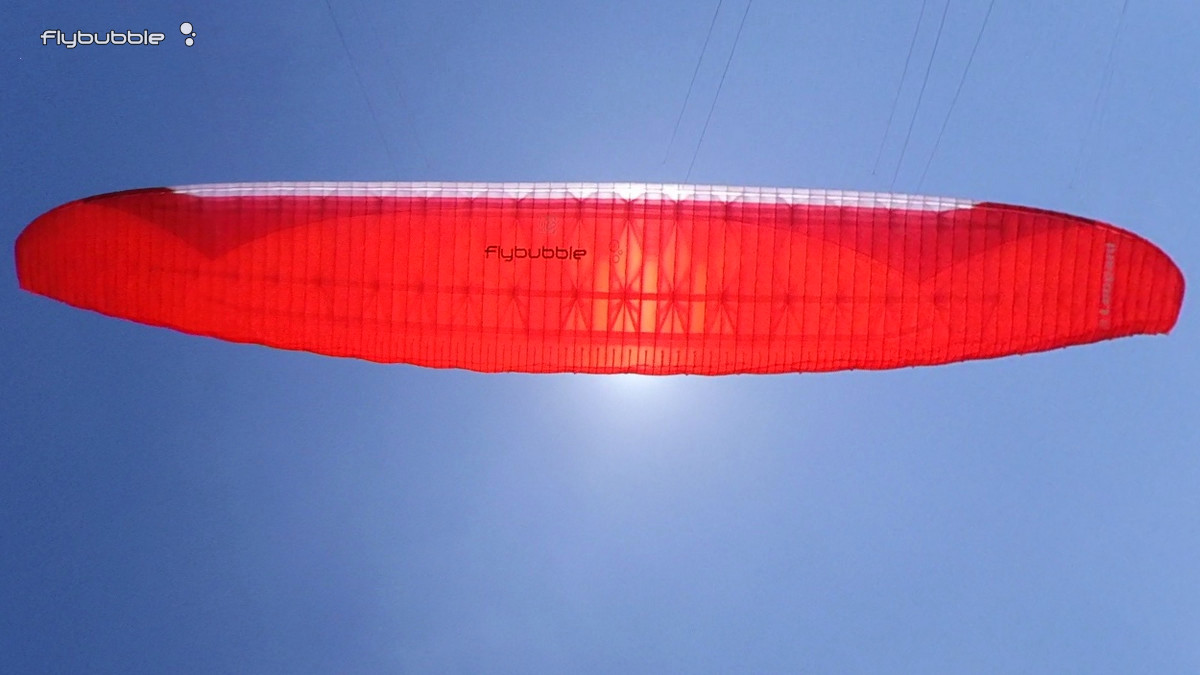
Good things come in threes
Low down the climbs were rough, scrappy and broken but the three of us were close enough to work together and use the stronger cores, a few minutes later we got a proper climb and we all managed to climb up within tens of metres of each other.
 Getting up in a proper climb together.
Getting up in a proper climb together.Climbing together is crucial to making a 'team' flight like this work, once you get separated even by a 100m vertically it's very difficult to get back together, each pilot has a part to play in exploring the thermal, finding the strongest cores and climbing well.
As others find stronger sections so you have to adjust and move your thermal turns, the one who fails to climb is guaranteed to get left behind.
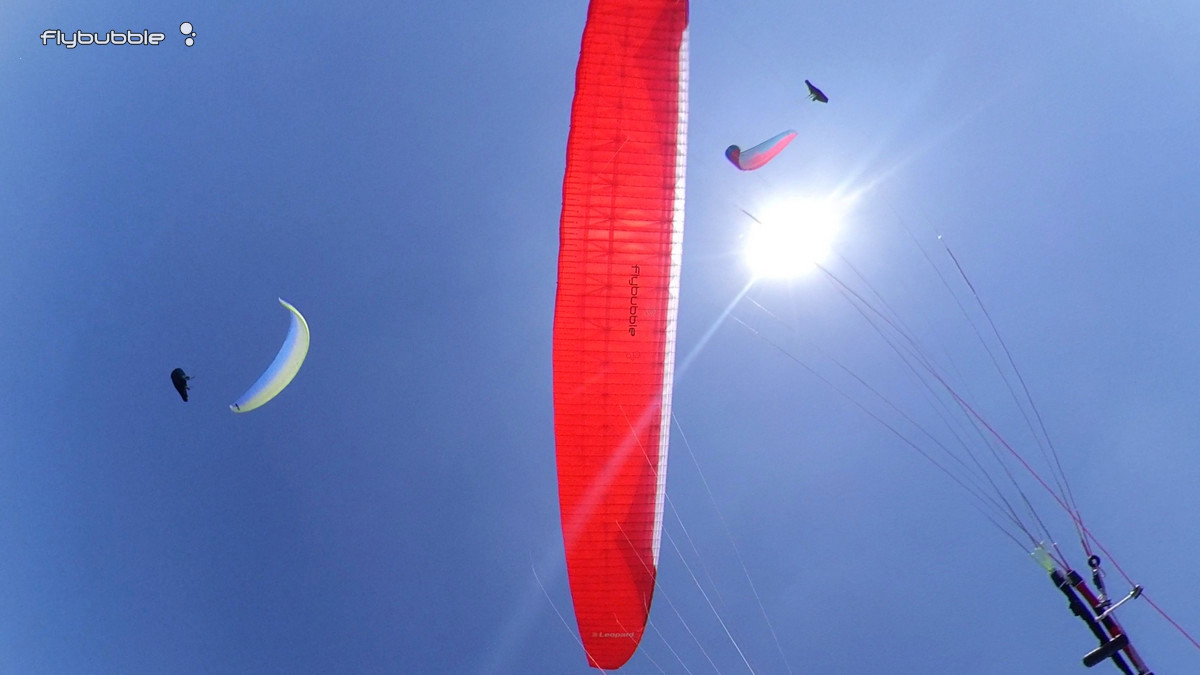
You snooze, you lose (first the lift, then the pack)
This kind of flying requires constant attention to the glider, the vario, the harness, the pilots around you, the task, the weather, etc. The workload can be quite intense so it's best to be sure you are unconsciously competent with as much of your flying as you can be. It's also best to be fit, rested, hydrated and free from stress.
If you have new kit, don't be doing new things too, one new thing at a time.
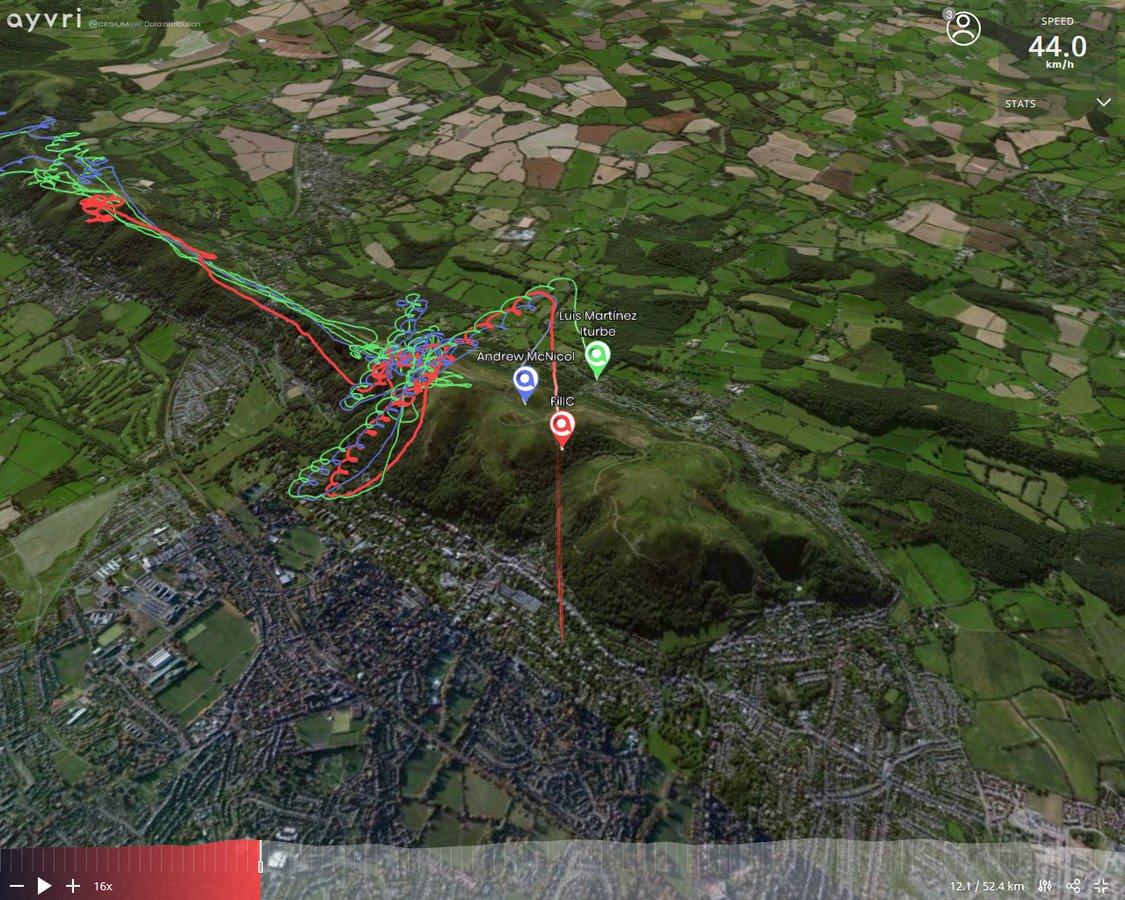 Having made the most of the climb, time to move on.
Having made the most of the climb, time to move on.Time to glide
When it's time to go gliding together you need to spread out and you cannot be afraid to take the lead, "straight though sink and turn in lift" is the mantra, here we are pushing out on the top of the first big climb (screenshot above).

Notice in the screenshot below how quick Luis and Andy are to clock the climb I found and then moving over to join me.
We were flying without radios so this was all about observation.
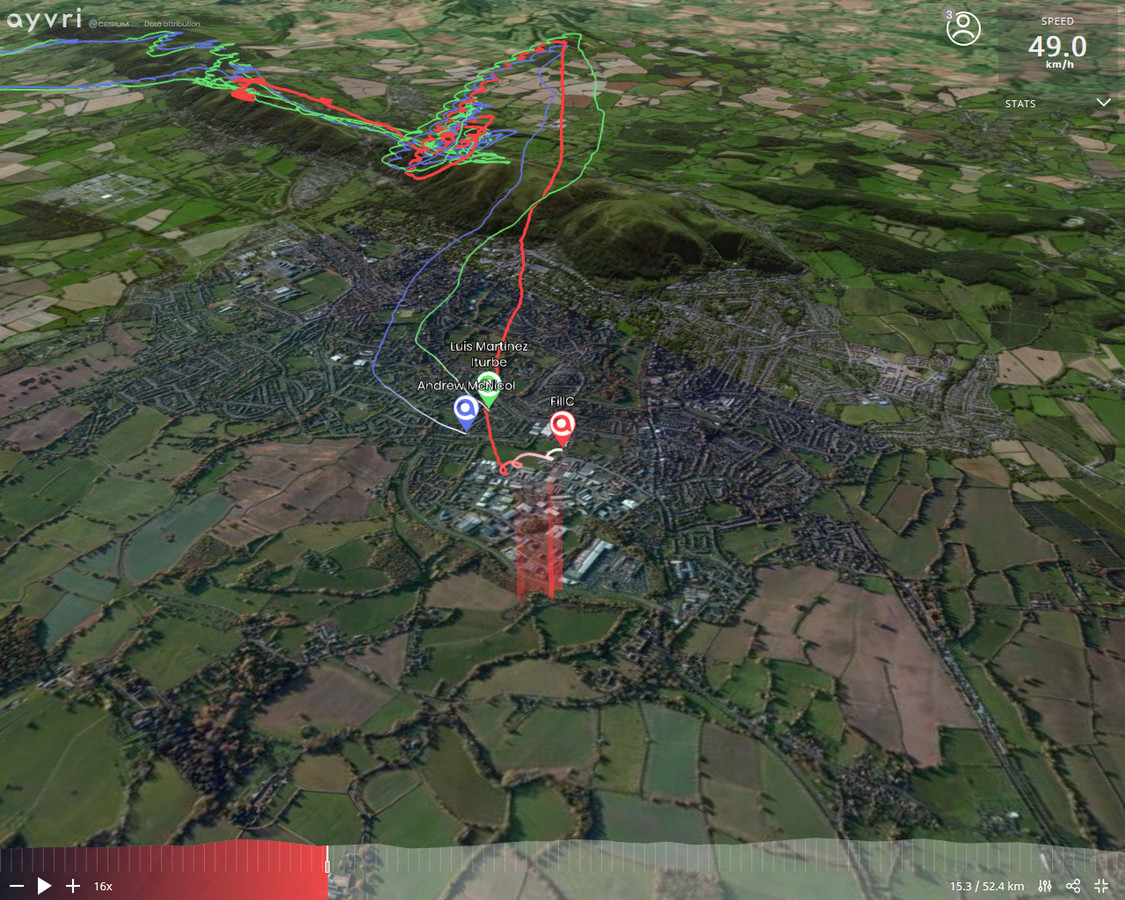
Power of the pack
The day was initially blue, no cumulus or haze domes to mark the climbs so we just had to fly straight and wait for the vario.
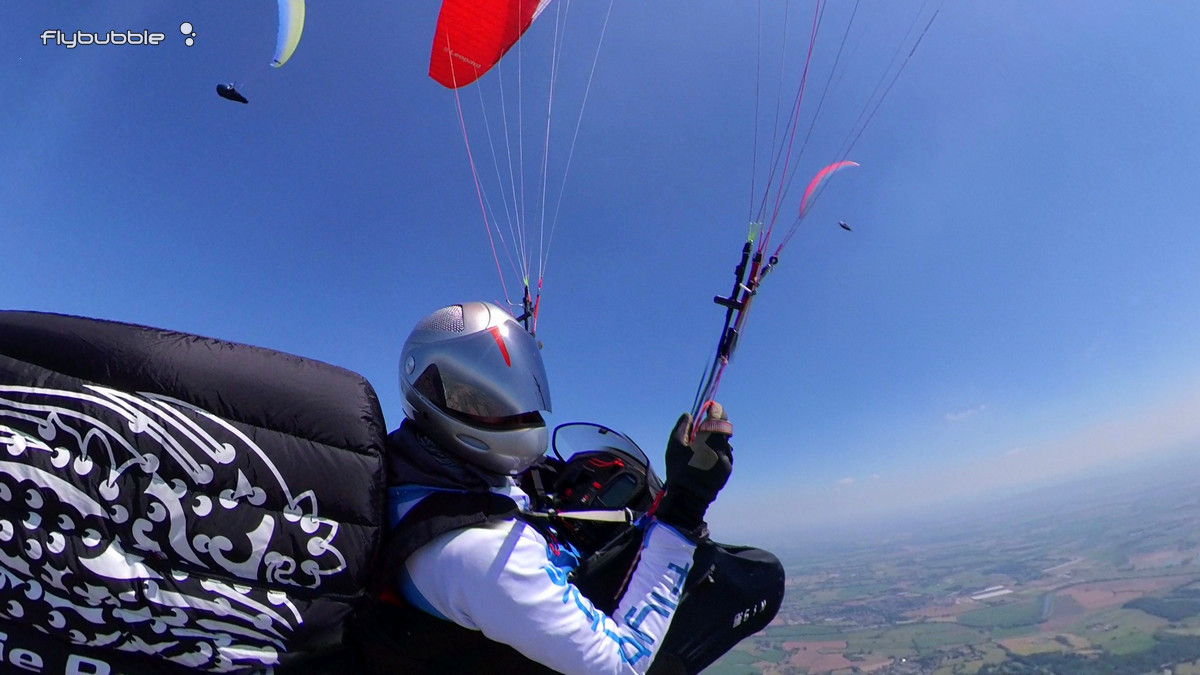
If you're first to find the climb then allowing the others to catch up is crucial but then once we're at similar heights it's back to 'crank and bank' mode to make the most of those tight punchy cores.
Luis actually left the 2nd climb first but the straighter, more direct line sees me edge ahead.
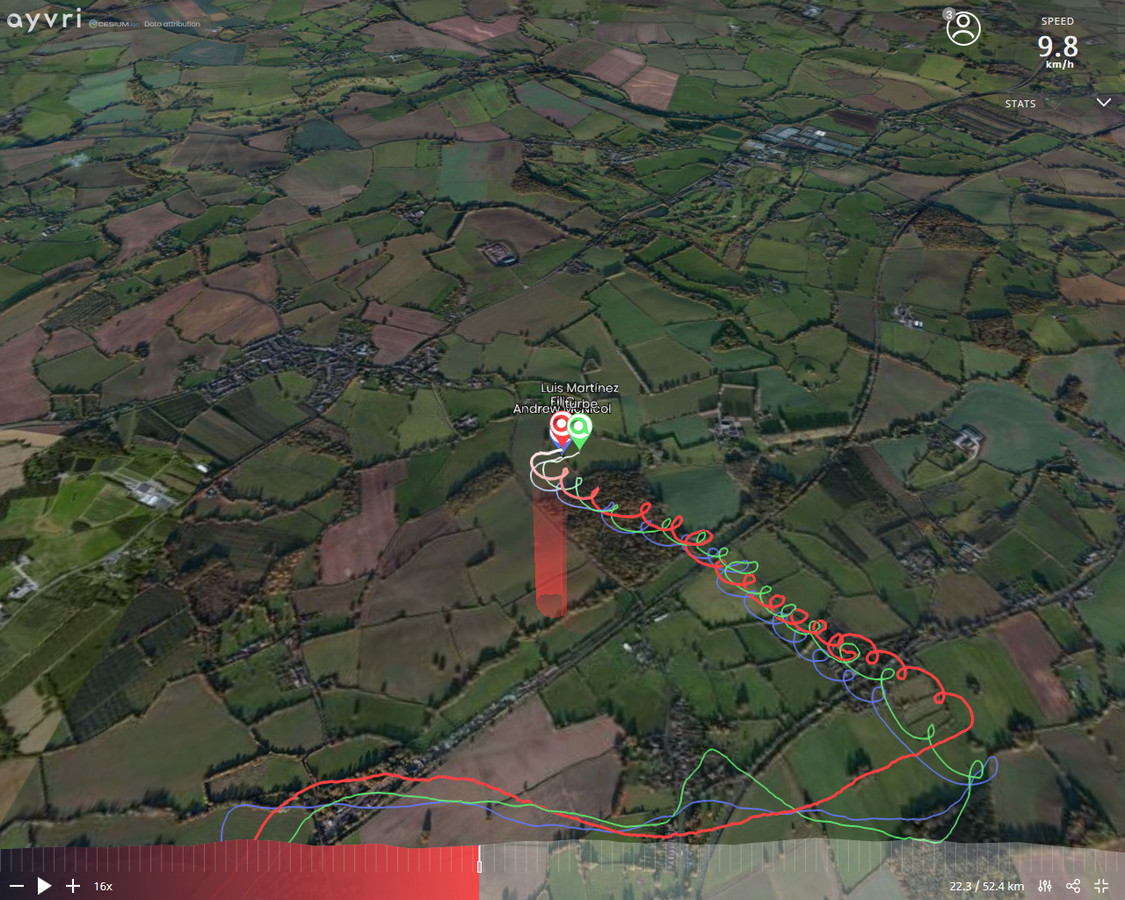 Three amigos, at the top of climb three.
Three amigos, at the top of climb three.Teamwork
You can see from the screenshot above where I'd gone for left turns initially and then switched to right hand 360s as we merged turns and the cores came together.
Now we were established in the climb, glide repeat phase of the flight, consistently topping out and then setting off together.
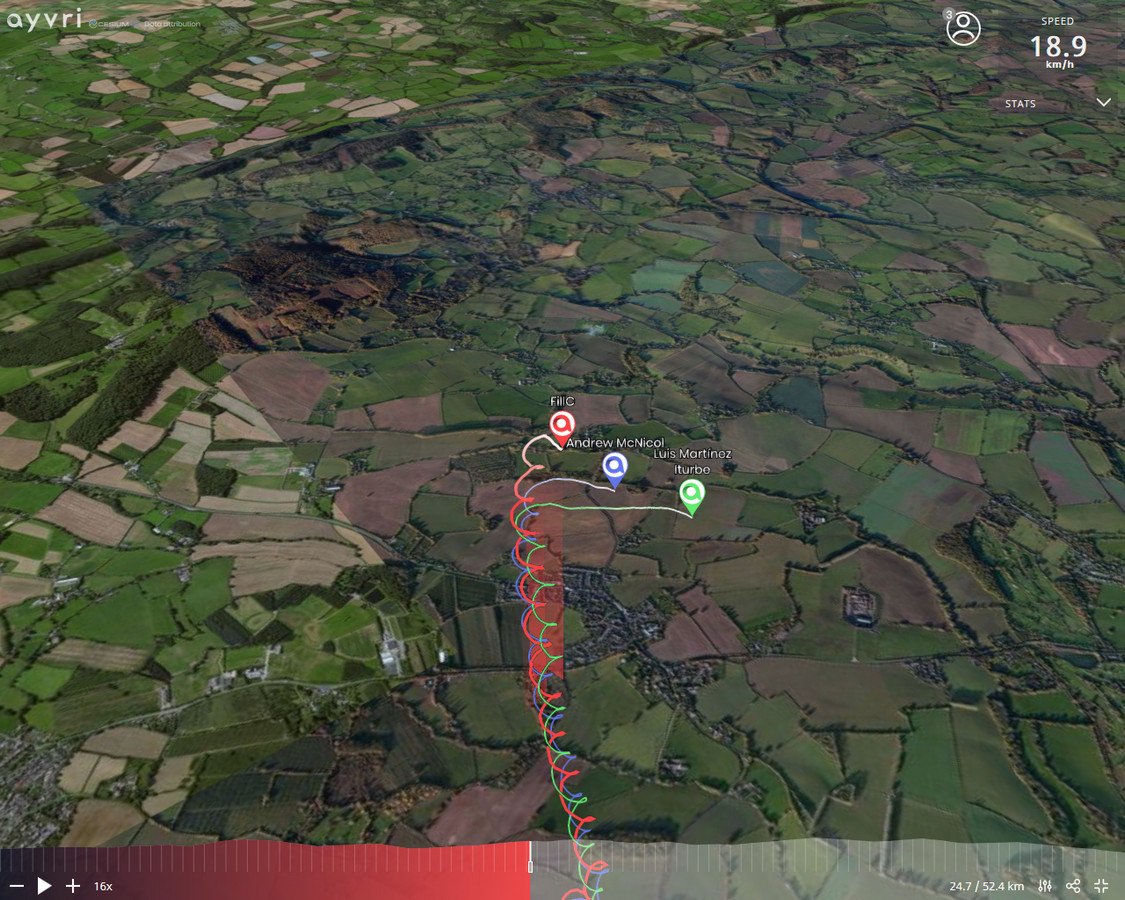
Dreamwork
Once you get in a routine it's important to take turns to lead out, like drafting on a push bike it's not fair to keep one person at the front, but we're coming to the point where we split anyway.
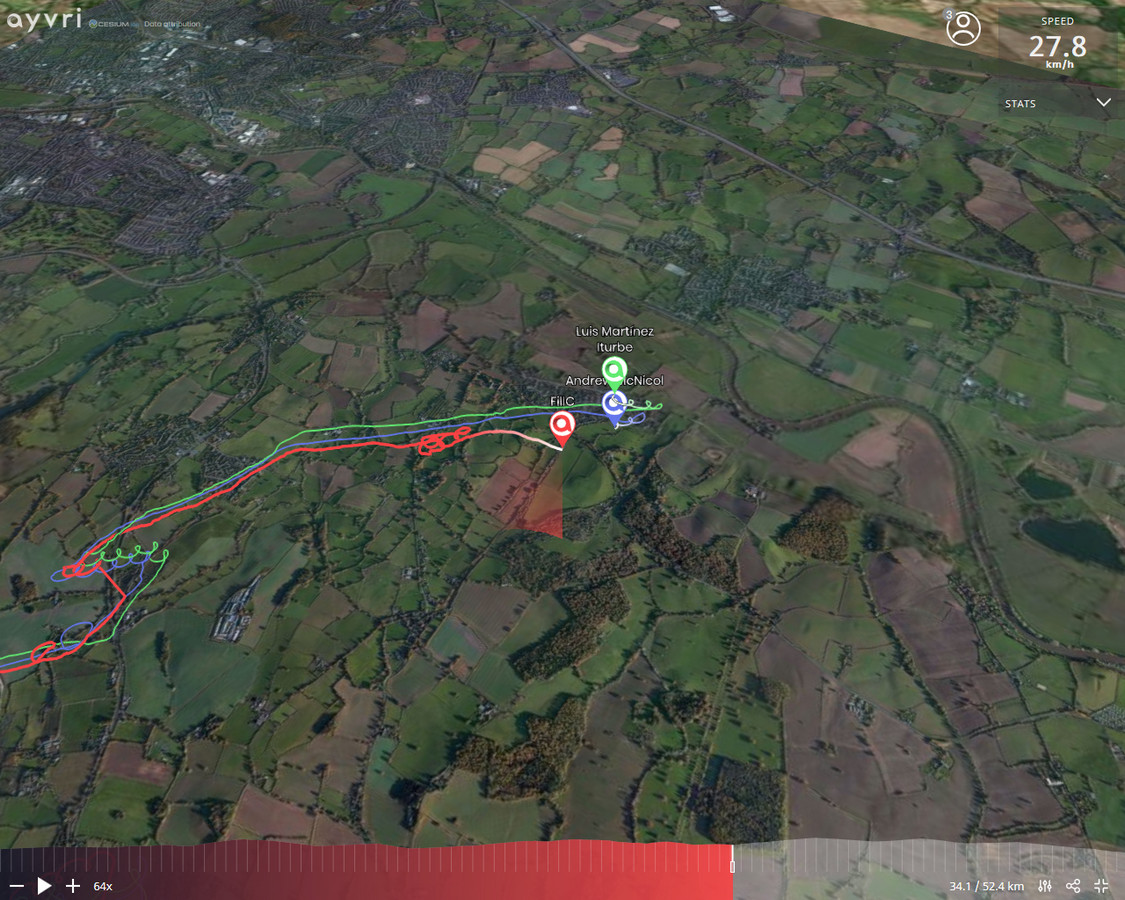
Faff at your peril
I'd spent some time faffing with a camera and the other two found a cracking climb, by the time I got there they were 200m above and I'd lost touch with them.
Once I was at the top of the climb I assumed they'd pushed on down track but in fact they'd bailed on the task.
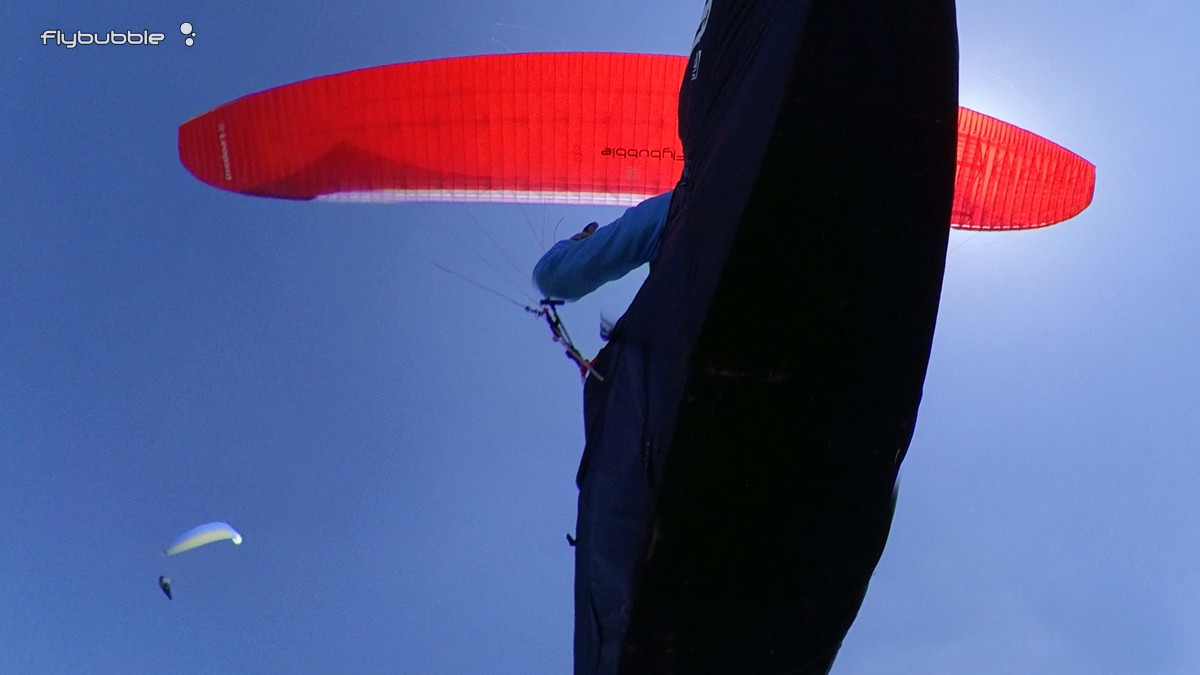
Electronic assistance
If I had been using the buddies link on my Flymaster vario or some device with a livetrack feed or FANET+ on it then I might have realised where they'd gone.
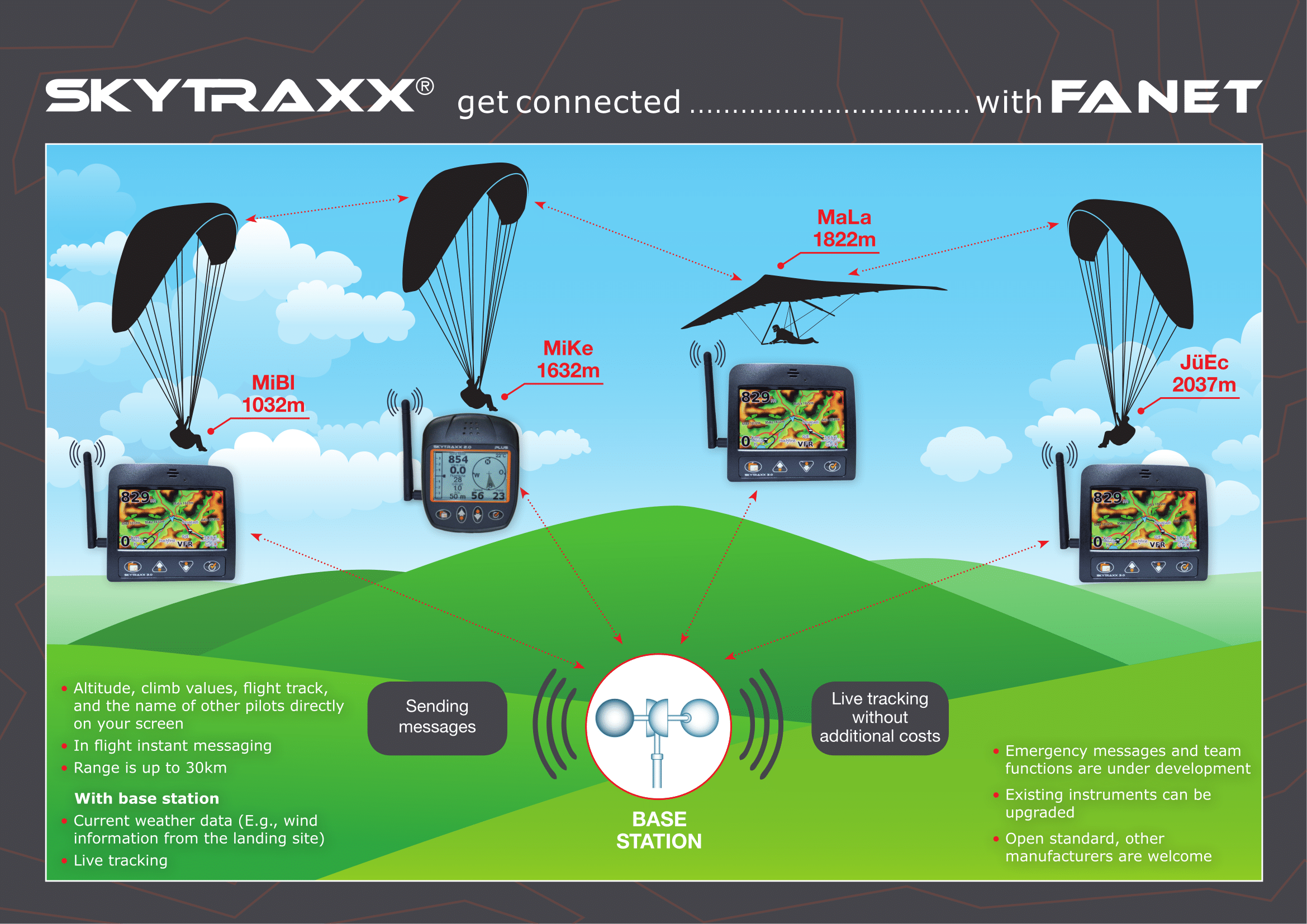
I could have also taken a radio, bearing mind their limitations and legal situation.
I'd even written about this before in our 'Learning From Tracklogs' series of articles.
As it was I topped out, looked downtrack and failed to realise they were at my relative 3 to 4 o'clock position.
Han solo
I pressed on. The turn point was in a big town, baking in the sun. We'd found a bunch of climbs already and all they had to do was get stuck low and I'd be sure to catch them up!
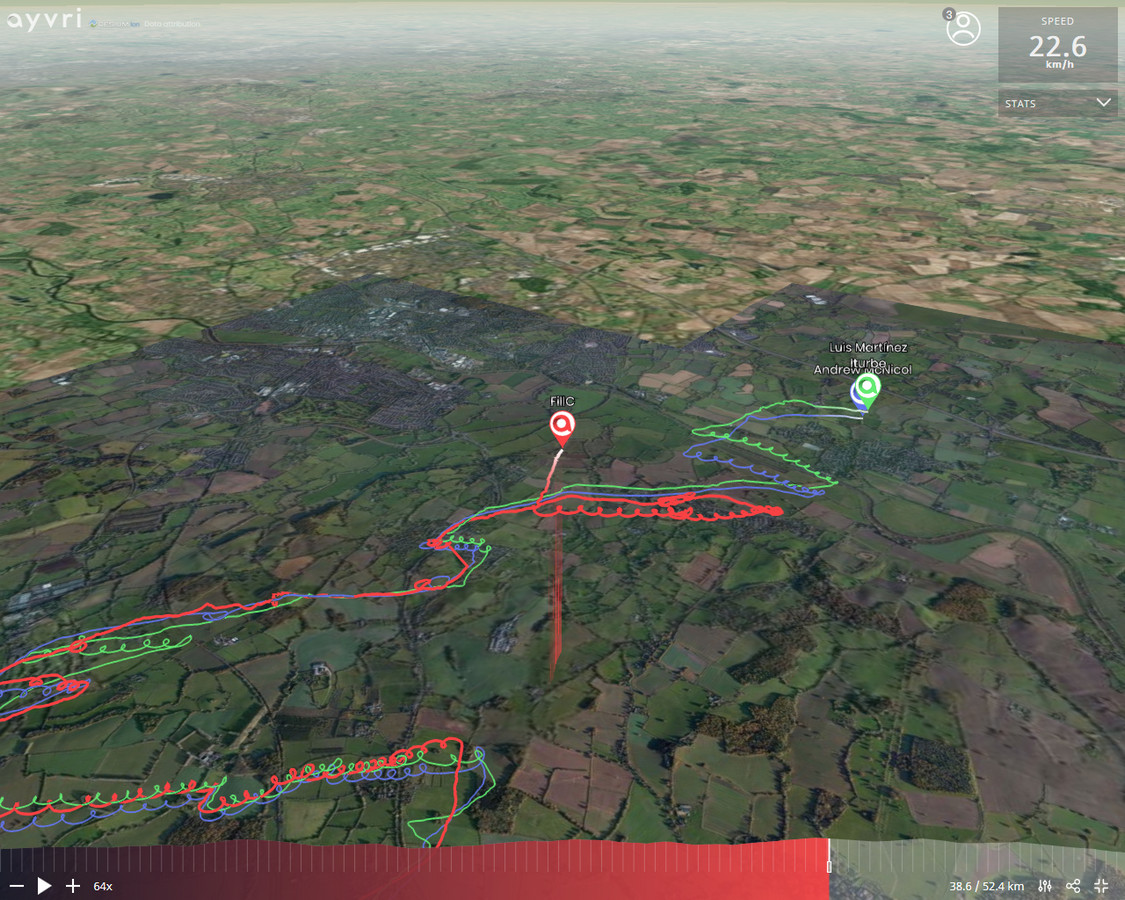
With the benefits of flying as a team now gone I pressed on.
Eventually I figured I could take the turn point and still have 300m to 400m over the ground, certain there'd be a climb there.
As it turned out I got absolutely drilled by sink all the way to the ground. Doh!
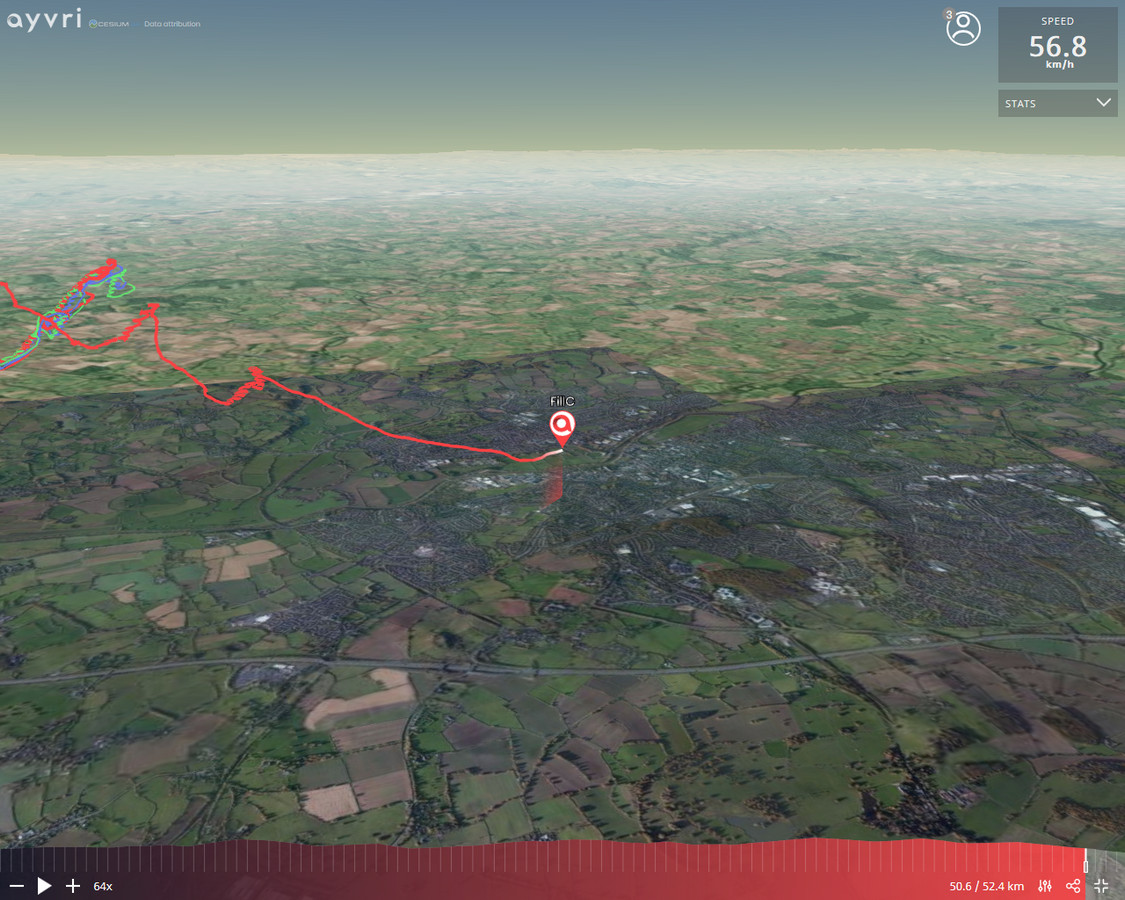
All good things...
With the benefit of hindsight, I think the climbs were breaking-off the downwind side of the town.
I think maybe the side of town I was on was in some sort of generally sinking flow (see Honza's articles in XCmag).
Time to put it down and pack it up...
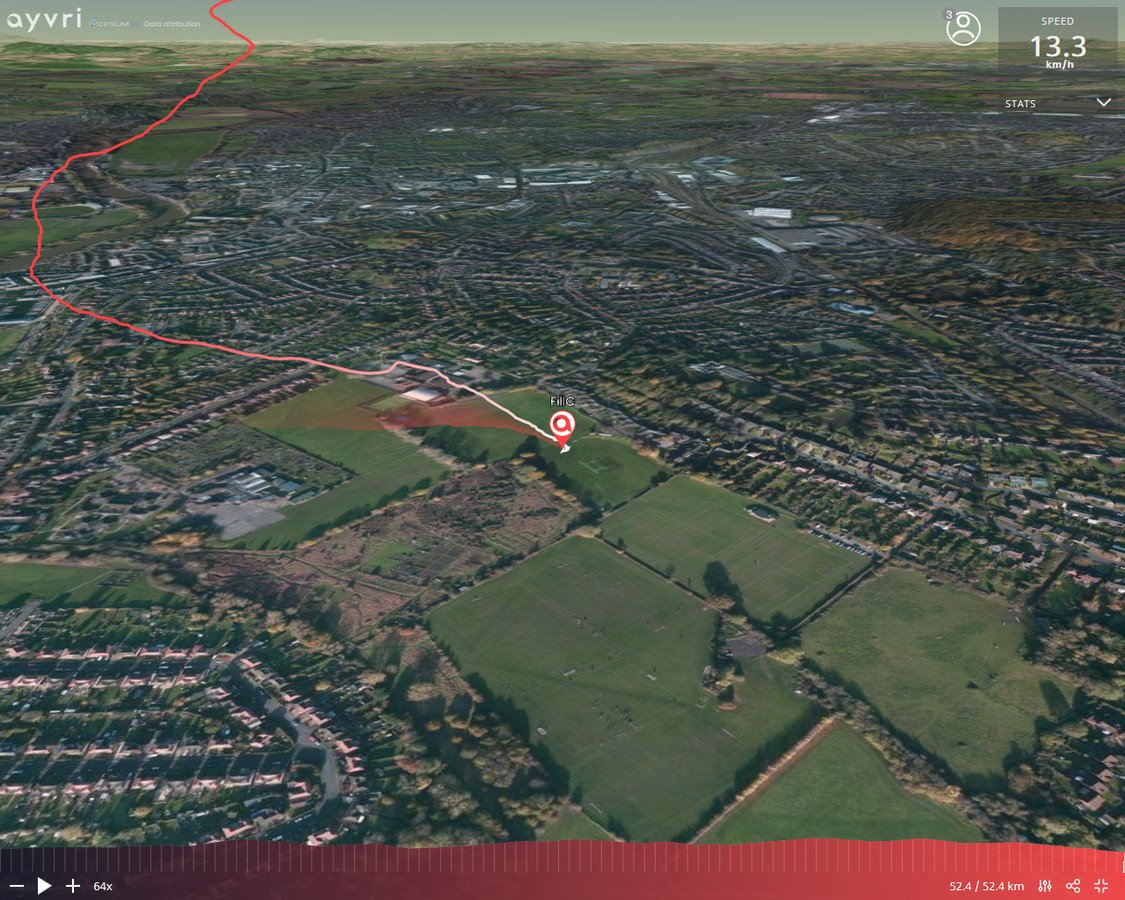
Not sure if you can see the power lines running through the field centre and below in the image above...
The last 100m to the ground was straight into wind but I'd given up hopes of climbing out once below 200m agl.
The field I landed in I'd actually chosen on the way to the turn point, once I realised my day was done it was simply a case of sticking to it, not stacking it in.
The remains of the day
Later that day it really switched on. Others flew longer and higher. Andy and Luis headed into-wind and then south. Andy closed a sizable FAI triangle and got to 2000m asl later in the day.
In retrospect had we hung on until that extra height was available we might have had an easier time of it. But hey, I'm well chuffed with nearly 2 hours out of ridge lift and clocking up a third of this year's airtime!
Satisfaction being reality divided by expectations, I was well-satisfied and as a bonus it turns out I kinda 'won' the day too. No one else got out as far as the first turn point on the task, so after eight years out of competitive flying I can still take a win, whoop-whoop! ;-)
Here's a short video clip from the flight, giving a tiny taster of the sweet flying fun we had together...
Key learning points
My four key takeaways from this flight are...
1. Get your act together
Be ready to fly when it's flyable.
2. Committed, yet flexible
Just because a task was set, doesn't mean you have to follow the arrow.
3. Stay together
There's strength in numbers! Within 20mins of getting separated I was on the ground. Consider radios (bearing mind their limitations and legal situation), especially on a vol biv.
4. Safety first
Be mindful of pushing it and always leave a healthy margin for error. A prang is never good, even near civilisation. If you're further afield things can soon turn sour¹.
¹ If you're flying XC then you really should consider at least one reliable tracking device that will feed your location to servers, so if you don't show up later in the day then at least your buddies know where to start looking. I use my Flymaster Live SD vario to broadcast my position via mobile data. My experience has been that from the air the live track from mobile data is actually pretty good, you only get drop outs when you get closer to the ground and that's good enough to suggest where people might begin searching if you went missing².
² Carlo at Flybubble adds his view on live tracking and safety, based on his experience: Since mobile data reception is not 100% everywhere, and can be very patchy in the more remote areas where we go flying, if you want to take your safety one step further then a reliable satellite tracking device with full satellite coverage is the way to go. In addition to broadcasting and sharing our positions to servers via FANET+ via our flight instruments, and mobile data through our smartphones, Nancy and I use Garmin inReach® Mini satellite communicator devices to broadcast our positions via satellite. The key feature of these is that they use the "100% global" Iridium satellite network which means they will continue broadcasting your position even in areas with no mobile data, as long as you have a good enough view of the sky. Another key feature is: "In case of emergency, trigger an interactive SOS message to GEOS, a professional 24/7 global monitoring and response center (satellite subscription required)." These devices are light and compact, and not too expensive. We don't sell them, since we at Flybubble focus our efforts on more freeflight specific equipment, but you can order them online via Garmin (see the link before) and elsewhere.
Equipment flown
Phil's paragliding kit on this flight:
- Wing: Gin Leopard (EN D 2-liner)
- Harness: Gin Genie Race 4 (race pod)
- Reserve: High Adventure Beamer 3 Light 130
- Instrument: Flymaster LIVE SD
- Helmet: Icaro 4fight Cut Integral Grid
- Other kit: Gin G-chute (drag chute), Gin XXL rucksack, Advance COMPRESSBAG TUBE, Advance Lightbag 20L
Where can I glide to next?
See a flythrough 3D visualisation of Phil, Andy and Luis' flight tracklogs here.
See Phil Clark's Flybubble team pilot profile
Brought to you by Flybubble
Like what we do? The best way to thank and support us is to buy gear from us and recommend us to others. Review our service on Trustpilot and our products on Flybubble Shop. You can also subscribe to Flybubble Patreon. Thank you!

